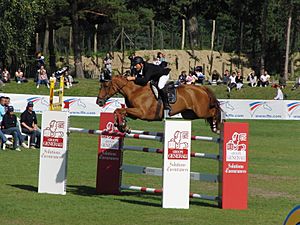Show jumping facts for kids

A competitor in a show jumping class
|
|
| Highest governing body | International Federation for Equestrian Sports (FEI) |
|---|---|
| Nicknames |
|
| Characteristics | |
| Contact | No |
| Team members | Individual and team at international levels |
| Mixed-sex | Yes |
| Type | indoor/outdoor |
| Equipment |
|
| Venue | Usually outdoor on grass or dirt-surfaced arena |
| Presence | |
| Country or region | Worldwide |
| Olympic | 1912 |
Show jumping is an exciting equestrian sport. It involves a rider and their horse jumping over obstacles. This sport uses a style of riding called English riding. The goal is to complete a course of jumps without making any mistakes. The International Federation for Equestrian Sports (FEI) sets the rules for this sport.
Show jumping became popular in the 1700s in England. Fox hunters needed to jump fences because of new land laws. This activity soon turned into a fun competition. In 1912, show jumping became an official sport at the Olympic Games. It is one of the few sports where men and women compete equally. For show jumping, horses need to be strong and have good stamina. They also need to be calm and quick. Some popular horse breeds for this sport are Selle Français, Anglo-Arabe, Oldenburg, Warmblood (like Holsteiner and Hanoverian), Thoroughbred, and Trakehner.
Contents
How Show Jumping Works: Rules and Scoring
To win a show jumping competition, the rider and horse must finish the course. They need to do this as fast as possible and without any errors. An error is called a "fault." A fault happens if the horse knocks down a fence. It also happens if the horse refuses to jump or runs past an obstacle.
Understanding Faults and Penalties
- If a horse makes a fault, the rider gets a penalty.
- Each mistake usually means losing four points.
- Riders can also lose points if they take too long. A penalty is added for every second over the time limit.
- A rider can be removed from the competition if they fall off. They can also be eliminated if they do not follow the course correctly.
- A special judge decides if a rider is eliminated. The judge also decides when this happens.
The Jump-Off: Deciding the Winner
Riders who complete the first course with no faults move on to the "jump-off." This is a shorter race. The goal is still to finish quickly and without any faults. The rider with the fastest time wins the competition. If faults are made in the jump-off, extra seconds are added to the final time. This is why the time score decides the winners.
Images for kids
See also
 In Spanish: Salto ecuestre para niños
In Spanish: Salto ecuestre para niños













